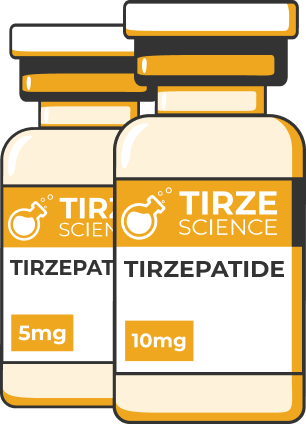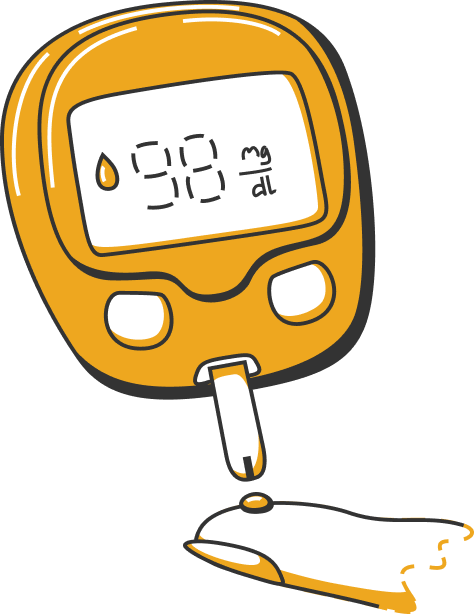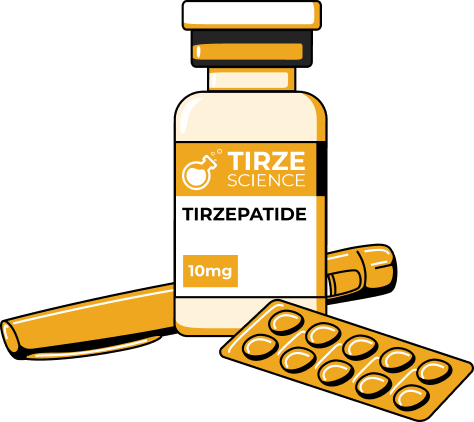- Home
Tirzepatide For Diabetes - Does It Work And How?
While numerous doctor-prescribed medications have successfully managed diabetes over the years, a new drug has appeared on the market that threatens to become an ultimate solution: Tirzepatide. This innovative medicine presents a promising solution in diabetes management, offering not just hope but tangible results for those struggling to control their blood sugar levels.
But what exactly is Tirzepatide, and how does it work to combat the complexities of diabetes? Let's get into the details!

How Does Tirzepatide Targets Blood Sugar Levels?

How Does Tirzepatide Targets Blood Sugar Levels?
To understand Tirzepatide's impact, it's crucial to look at its dual-action mechanism that targets the root causes of high blood sugar in a straightforward yet effective manner.
Boosts Insulin Release Efficiently: Insulin is a hormone that plays a key role in managing how much sugar stays in our blood. In people with diabetes, the body either doesn't produce enough insulin or can't use it effectively, leading to high blood sugar levels. Tirzepatide helps by encouraging the pancreas to release more insulin when blood sugar levels are high. This process ensures that sugar in the blood can be moved into cells where it's needed for energy, thereby lowering blood sugar levels.
Reduces Sugar Production in the Liver: The liver produces sugar and releases it into the bloodstream. However, in people with diabetes, the liver can produce too much sugar. Tirzepatide works by telling the liver to slow down its sugar production, which is crucial in preventing blood sugar levels from getting too high.
Slows Down Food Digestion: Food is broken down into sugar, which is then absorbed into the blood. Tirzepatide slows this process, meaning sugar enters the bloodstream more gradually, helping avoid spikes in blood sugar levels after meals.
The effectiveness of Tirzepatide in managing diabetes has been a subject of considerable interest within the medical community, particularly as revealed through various clinical trials. These studies are designed to rigorously test new treatments to ensure they're safe and effective before they become widely available. Here's what recent clinical trials tell us about Tirzepatide:
Significant Reduction in Blood Sugar Levels: Clinical trials have consistently shown that Tirzepatide effectively lowers blood sugar levels in people with type 2 diabetes. Participants in these studies who were given Tirzepatide experienced a substantial decrease in their blood sugar levels compared to those who did not receive this medication. This outcome is measured by a common blood test called HbA1c, which reflects average blood sugar levels over the past two to three months.
Weight Loss Benefits: In addition to lowering blood sugar levels, Tirzepatide has also been linked to significant weight loss in many participants. This is particularly notable because weight management is an important aspect of diabetes care. Losing weight boosts insulin sensitivity, enabling the body to control blood sugar levels easier.
Comparison with Other Diabetes Medications: Some clinical trials have compared Tirzepatide directly with other diabetes medications. The results have often shown Tirzepatide to be as effective, if not more so, in reducing blood sugar levels and aiding weight loss. This suggests that Tirzepatide could be a preferable option for some patients, depending on their health needs and circumstances.
Safety and Side Effects: While clinical trials often focus on the effectiveness of a new treatment, they also closely monitor safety and side effects. The trials have indicated that while Tirzepatide does not include severe side effects, it does cause nausea, diarrhea, and reduced appetite. However, they are usually mild to moderate in severity and tend to decrease over time.
Tirzepatide Compared to Current Diabetes Treatments
Tirzepatide Compared to Current Diabetes Treatments
Tirzepatide brings something different to the table compared to existing medications. Understanding how it stacks up against current treatments can help patients and healthcare providers make informed decisions
Tirzepatide mimics the actions of both GLP-1 and GIP hormones. This dual action allows it not just to enhance insulin release in response to high blood glucose but also to slow down gastric emptying and decrease glucagon release.
Other Diabetes Treatments vary in their approach. Oral medications like SGLT2 inhibitors reduce blood sugar by preventing glucose reabsorption in the kidneys. GLP-1 receptor agonists (like Liraglutide) enhance insulin release but do not mimic GIP. Insulin injections directly replace or supplement the body's insufficient insulin.

Many patients report a marked improvement in blood sugar levels after starting Tirzepatide. This often translates to lower HbA1c readings, demonstrating better control over glucose levels over time. For many, this improvement means meeting their blood sugar management goals for the first time after trying various other treatments without success.
Some individuals have shared that their dependence on additional diabetes medications has decreased since they began using Tirzepatide. Due to its effectiveness, healthcare providers may adjust other medications, reducing the overall medication burden for the patient. This simplification of treatment regimens is a significant benefit, making daily diabetes management less complex and more manageable.
Besides improving long-term blood sugar control, patients often note that Tirzepatide helps stabilize their daily glucose readings. They experience fewer spikes and drops, leading to more predictable and stable blood sugar levels throughout the day. This stability is crucial for avoiding the immediate symptoms of hyperglycemia (high blood sugar) and hypoglycemia (low blood sugar), contributing to a more consistent feeling of well-being.
Improved glycemic control with Tirzepatide potentially mitigates risks associated with long-term diabetes complications, such as heart disease, kidney damage, and neuropathy. While specific mentions of these outcomes are more likely to emerge over time, the initial control of blood sugar levels is a promising step toward healthier patient futures.